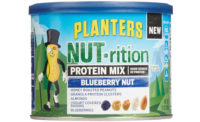It’s safe to say COVID-19 has made its mark on the food industry. People are cooking more at home than they used to. They’ve having happy hour on Zoom instead of at the local pub. And they’re searching for snacks that will bring them comfort in a time of uncertainty.
“Due to a heightened interest in comfort foods and shelf-stable items, the snack category has experienced increasing demand,” explains Kristen Holden, retail sales and marketing manager, Mariani Nut Co., Winters, CA. “Consumers are gravitating toward foods that might make their social distancing more tolerable.”
Overview | Chips | Puffed/Extruded Snacks | Popcorn | Snack Mixes & Nuts | Tortilla Chips | Pretzels | Frozen Snacks | Crackers
And snacks are generally considered essential. According to a survey conducted by the California Walnut Board and Commission, Folsom, CA, in partnership with Kelton Global, 98 percent of Americans snack daily, and 48 percent say they’re snacking even more since stay-at-home mandates began. “With many Americans turning to snacks to satisfy their cravings, the snack mix and nut category is perfectly poised for growth,” says Jennifer Olmstead, marketing director for domestic public relations.
Market data
Data from IRI, Chicago shows that snack nuts held steady for the 52 weeks ending May 17, 2020, with 0.9 percent growth to $4.9 billion in sales. The brightest spot came from private label, which leads the segment and saw 8.5 percent growth to $1.7 billion. Kraft Heinz took a slight dip, with its flagship Planters brand down 0.5 percent to $915.3 million. Wonderful likewise saw a slight loss in traction, down 1.9 percent to $734.5 million. Blue Diamond had a slight uptick, growing 0.4 percent to $542.2 million.
The nutritional snacks/trail mixes segment of “other snacks” saw slightly better performance, up 1.3 percent for the year to sales of $1.2 billion. Private label again leads the way, up 5.6 percent to $592.7 million. While Kraft Heinz overall dropped 5.9 percent in the segment to $83.7 million, its Planters NUT-rition line grew 15.1 percent to $25.6 million. Another bright spot was the Southern Style Nuts line from John B. Sanfilippo & Son, up 27.7 percent to 20.4 million. Also, Gourmet Nut’s Power Up line grew 29.9 percent to $17.1 million.
Looking back
“Consumer need for convenience has been a major growth driver for the snack industry, and especially for snack mixes, which can suit a variety of different occasions and be taken on the go,” says Laura Gerhard, director of strategy and marketing, Blue Diamond Almonds Global Ingredients Division, Sacramento, CA. Not only do many consumers lead busy lives and snack more frequently throughout the day, but they’re also increasingly concerned with the health attributes of the food choices they make, which bodes well for this category.
“Increasingly, they’re opting for snacks that can offer them nutritional benefits, such as vitamins, minerals, and an energy boost through added protein,” says Gerhard. “Consumers also seek out snack products that are aligned with their individual diet preferences, whether its vegan, vegetarian, or gluten-free.”
Snack mix brands are rising to the occasion, offering options that meet a variety of consumer preferences and eating occasions, which is further driving sales, says Harbinder Maan, associate director of trade marketing and stewardship, Almond Board of California, Modesto, CA. “Snack mixes and nuts have proven themselves perfect for any time of day, and we’ve seen product introductions framing benefits for any occasion, whether providing energy to start the day, an afternoon pick-me-up, or an indulgent moment between meals.”
In the snack mix category, better-for-you trends have dominated the past year, as they reach mainstream status and gain traction with shoppers across all demographics. “Healthy snacking is motivated by desire for energy, to maintain a healthy lifestyle and to manage weight,” says Holden. “Opportunity continues to exist for better-for-you snacks to be positioned as solutions for improving health.” Attributes that appeal to snack mix shoppers include fresh ingredients, low sugar, low salt, high protein, and high fiber, she adds.
At Blue Diamond, Gerhard sees increasing demand for functional, better-for-you snack mixes, with an emphasis on those offering a clean label, protein, and all-natural ingredients. “The clean-label movement has helped create renewed interest in plant-based ingredients as ‘clean’ ingredients, and consumers are incorporating more fruits, seeds, and nuts into the foods they eat,” she says. Protein claims, especially, are expanding beyond the functional space and becoming a must-have for any snack positioned as better-for-you.
“These trends are leading new innovation in snack mixes, including new styles and formats like the bento box, which has an emphasis on protein and other healthful, whole-food ingredients,” Gerhard explains. Popular bento box pairings include almonds with apple slices, grapes, and cheese slices. “Trail mixes are also seeing more innovative and diverse ingredient combinations, pairing traditional nuts, seeds, and berries with more-exciting additions like dried tropical fruits, wasabi peas, chia sticks, and more.”
Today’s consumers also crave a multi-sensory experience, which snack mixes and nuts can provide, says Maan. Plus, they want adventurous flavors, bold blends, and interesting textures.
Flavor trends were on display at a recent food trends tour hosted in Sacramento, CA by the Almond Board of California. Big Al’s Sweet and Salty Mixed Nuts, from Napa Nuts, meets flavor demands with jalapeño Cheddar almonds, orange honey almonds, smoked almonds, chili lemon cashews, and mixed nuts. Maisie Jane’s California Sunshine debuted snack mix flavors like cinnamon vanilla, spicy tamari, and herb and garlic. “Both companies demonstrate that almonds can be seasoned or coated to capture flavor trends,” says Maan.
Mariani Nut Co. recently launched a line of seasoned almonds. “Featuring natural, sweet, and savory seasonings, our snack almond line offers flavors that satisfy any craving,” Holden says. The products are formulated without artificial flavors or MSG, and all seasonings are gluten-free. “Additionally, our stand-up pouches are convenient, lightweight, and keep products fresh, which makes them perfect for enjoying on the go.” The line now includes flavors like Wasabi & Soy, Sweet BBQ, Hickory Smoke, and Roasted & Salted, alongside traditional offerings like Cinnamon Twist, Plain, and Honey Roasted.
“With a naturally subtle flavor and a range of versatile forms, almonds support continued innovation in the snack mix category,” says Gerhard. “Almonds have the ability to carry a wide range of seasonings and coatings, which makes them customizable to any flavor pairing or recipe.”
Maan notes that roasting almonds can be an especially valuable tactic for snack mixes, as roasting emphasizes the natural attributes of the nut while deepening the color and flavor profile and creating a crispier and crunchier texture.
Walnuts are also receiving a range of adventurous flavor treatments. “Brands like Crazy Go Nuts, The Nutty Gourmet, and Diamond have expanded their offerings in the past year to include delightfully seasoned walnut snacks in flavors like chocolate espresso, buffalo, rosemary, teriyaki, and wasabi,” says Olmstead.
Looking forward
Looking ahead to the next year and beyond, the trends that dominated snack mixes in the past will continue to lead, albeit with more intensity. For example, Gerhard expects consumers to look for more interesting and innovative flavors inspired by global cuisine.
Holden expects an increased focus on nutrition—even though the COVID-19 pandemic caused some initial regression toward comfort foods, she says. In fact, California Walnut Board research shows that 40 percent of consumers anticipate that their increased snacking that began with stay-in-place orders will remain after these mandates are lifted. And what they’ll want are snack mixes that can satisfy cravings and also provide a nutrition boost.
“Our research shows that consumers react most positively to our ‘healthy’ and ‘energizing’ product attributes,” Holden says. “However, emerging is ‘plant-based protein’ and ‘plant-based energy,’ and we are watching that very closely.”
Gerhard also expects plant-based protein ingredients to be an important differentiator for snack mixes, creating more opportunities for options like almonds going forward.
According to Maan, functional claims will only continue to evolve in the snack mix market in the years ahead. “People are taking a more-holistic approach toward health, increasingly counting not only physical, but emotional balance, among their key priorities,” she says. “We’re looking forward to seeing how holistic wellness and benefits like mood management affect the functional ingredients with which product developers formulate.”
Overview | Chips | Puffed/Extruded Snacks | Popcorn | Snack Mixes & Nuts | Tortilla Chips | Pretzels | Frozen Snacks | Crackers








